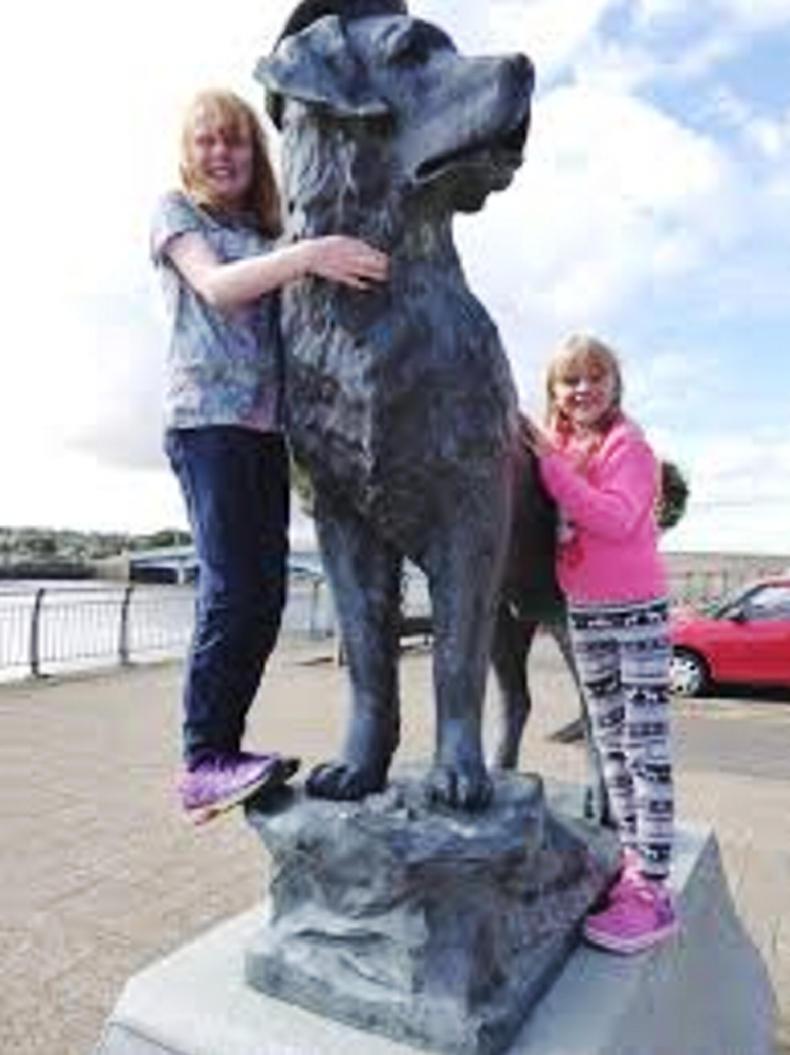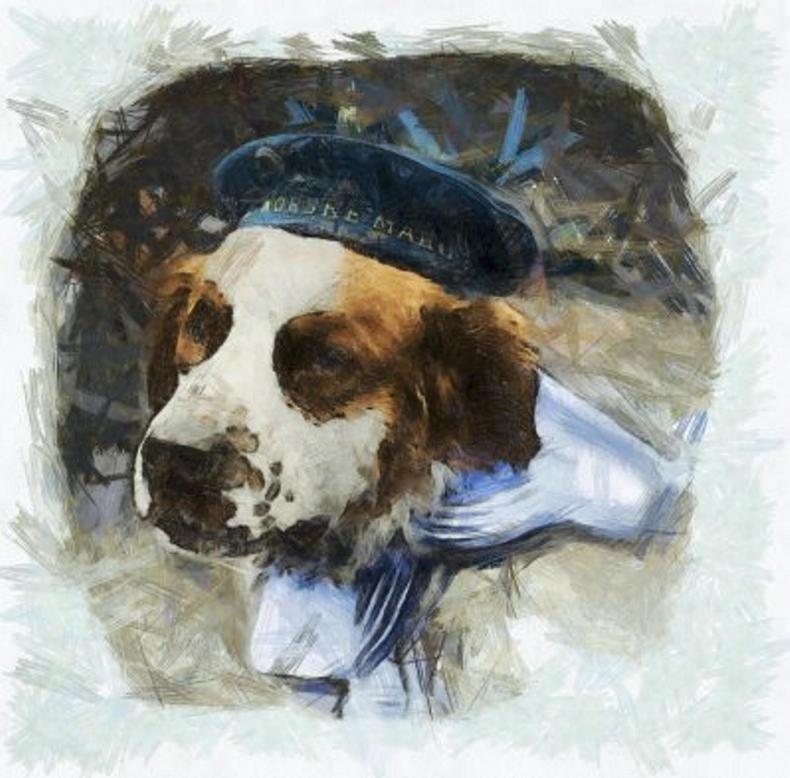Bamse (pronounced “Bump-sa”, the Norwegian word for “teddy bear”) was a Saint Bernard, who, during World War II, became the heroic mascot of the Free Norwegian Forces.
Even before the war began, Bamse had shown extraordinary devotion to duty, as the family pet to Captain Erling Hafto’s family. Best demonstrated when the captain’s youngest child, Vigdis, took a bad turn. Vigdis, herself, later wrote “When I was just a child I became very ill, and was not expected to live. For 12 days and nights Bamse guarded my bedside, and would not let anyone approach, except my mother and the doctor. He did not leave his post until the crisis was over.”
During World War II, before the fall of Norway, Captain Hafto and his crew on the Thorodd were able to escape to Scotland. The ship was stationed at Dundee and Montrose and was used as a minesweeper.

When off duty, Bamse would wear a sailor’s collar and mariner’s cap.
The Captain had taken Bamse with him and made him an official member of the Royal Norwegian Navy – the ship’s mascot. During action he would stand guard in the foremost gun tower, wearing a steel helmet, and would not leave his post until all was safe. During downtime he would go ashore and roam the area, wearing a sailor’s collar and mariner’s cap, becoming a favourite among the townspeople. Bamse even had a bus pass which he wore around his neck, often boarding the bus on his own, climbing to the top deck where he was allowed to sit.
Bamse knew which pubs the crew frequented and when they had to be back on the ship. He made sure they returned to the ship before curfew and when a pub brawl involved one of his men he would place his front paws on the offender’s shoulders, putting an immediate end to the fight.

During action Bamse would stand guard in the foremost gun tower, wearing a steel helmet.
Bamse was also credited for saving the lives of two of his men. One was Lieutenant Commander Nilsen. While walking along the quayside, the Commander was attacked by a man wielding a knife. Ever alert, Bamse saw the attack. “Rising up onto his hind legs he used his momentum and his great weight to push the man away from my father.” So Dr Willie Jarl Nilsen, the Commander’s son, would write afterwards: “Continuing to push him, Bamse steered the staggering man to the edge of the quay, and propelled him into the water below.”
The other, recorded, life-saving action performed by Bamse, was when a crew member, believed to have been drunk, fell overboard. Bamse was the only one to notice the fall. He alerted the men with his loud barking, jumped into the water, and struggled to keep the man afloat until both of them were safely pulled aboard.

Bamse has been honoured with life-sized statues in Scotland and Norway.
In Montrose, on 22 July 1944, Bamse died of a failed heart. He was buried with full military honours in the sand dunes on the banks of the South Esk River in Montrose. Norwegian sailors, allied servicemen and townspeople were present. Schools even closed for the day so hundreds of children could attend the funeral.
Bamse was posthumously awarded the PDSA Gold Medal in 2006 for his exceptional acts of gallantry and devotion to duty, the only World War II animal to have received this honour. There are statues commemorating the brave sea dog in both Montrose and outside the North Cape museum in Honningsvag. During 2016, in Cumbria, England, Bamse was honoured with the planting of a 17 acre forest named “Bamse’s Wood.”
Read more
Reader Writes: let your dog help lower your anxiety
My Farming Week: Ciaran Sheelan, Carlingford, Co Louth
Farmer Writes: there's a time and place for everything
Bamse (pronounced “Bump-sa”, the Norwegian word for “teddy bear”) was a Saint Bernard, who, during World War II, became the heroic mascot of the Free Norwegian Forces.
Even before the war began, Bamse had shown extraordinary devotion to duty, as the family pet to Captain Erling Hafto’s family. Best demonstrated when the captain’s youngest child, Vigdis, took a bad turn. Vigdis, herself, later wrote “When I was just a child I became very ill, and was not expected to live. For 12 days and nights Bamse guarded my bedside, and would not let anyone approach, except my mother and the doctor. He did not leave his post until the crisis was over.”
During World War II, before the fall of Norway, Captain Hafto and his crew on the Thorodd were able to escape to Scotland. The ship was stationed at Dundee and Montrose and was used as a minesweeper.

When off duty, Bamse would wear a sailor’s collar and mariner’s cap.
The Captain had taken Bamse with him and made him an official member of the Royal Norwegian Navy – the ship’s mascot. During action he would stand guard in the foremost gun tower, wearing a steel helmet, and would not leave his post until all was safe. During downtime he would go ashore and roam the area, wearing a sailor’s collar and mariner’s cap, becoming a favourite among the townspeople. Bamse even had a bus pass which he wore around his neck, often boarding the bus on his own, climbing to the top deck where he was allowed to sit.
Bamse knew which pubs the crew frequented and when they had to be back on the ship. He made sure they returned to the ship before curfew and when a pub brawl involved one of his men he would place his front paws on the offender’s shoulders, putting an immediate end to the fight.

During action Bamse would stand guard in the foremost gun tower, wearing a steel helmet.
Bamse was also credited for saving the lives of two of his men. One was Lieutenant Commander Nilsen. While walking along the quayside, the Commander was attacked by a man wielding a knife. Ever alert, Bamse saw the attack. “Rising up onto his hind legs he used his momentum and his great weight to push the man away from my father.” So Dr Willie Jarl Nilsen, the Commander’s son, would write afterwards: “Continuing to push him, Bamse steered the staggering man to the edge of the quay, and propelled him into the water below.”
The other, recorded, life-saving action performed by Bamse, was when a crew member, believed to have been drunk, fell overboard. Bamse was the only one to notice the fall. He alerted the men with his loud barking, jumped into the water, and struggled to keep the man afloat until both of them were safely pulled aboard.

Bamse has been honoured with life-sized statues in Scotland and Norway.
In Montrose, on 22 July 1944, Bamse died of a failed heart. He was buried with full military honours in the sand dunes on the banks of the South Esk River in Montrose. Norwegian sailors, allied servicemen and townspeople were present. Schools even closed for the day so hundreds of children could attend the funeral.
Bamse was posthumously awarded the PDSA Gold Medal in 2006 for his exceptional acts of gallantry and devotion to duty, the only World War II animal to have received this honour. There are statues commemorating the brave sea dog in both Montrose and outside the North Cape museum in Honningsvag. During 2016, in Cumbria, England, Bamse was honoured with the planting of a 17 acre forest named “Bamse’s Wood.”
Read more
Reader Writes: let your dog help lower your anxiety
My Farming Week: Ciaran Sheelan, Carlingford, Co Louth
Farmer Writes: there's a time and place for everything









SHARING OPTIONS